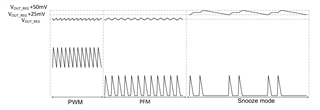Other Parts Discussed in Thread: TPS61299
Tool/software:
I am currently evaluating an issue related to the TPS610981.
It appears that when the load becomes lighter than a certain threshold, the V-main waveform begins to fluctuate.
Could this behavior be caused by the light load condition?
If so, how much additional load would be required to stabilize the output?
Please refer to the attached PDF for further details.
This issue has only recently surfaced and does not occur on all PCBAs. It seems that only a small percentage of boards—likely a few percent—are affected.
Furthermore, this behavior was not observed during the initial design and evaluation phases, but has been confirmed in recent production batches.
A key question is why this phenomenon occurs only on some PCBAs, despite all units being manufactured under the same conditions.


